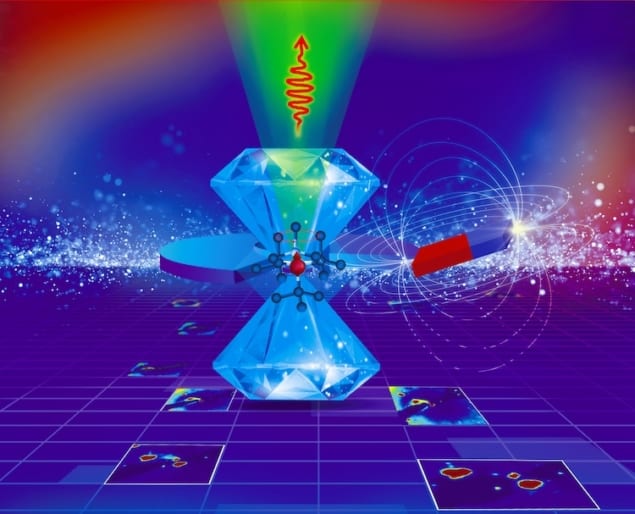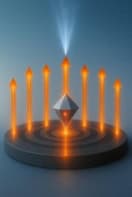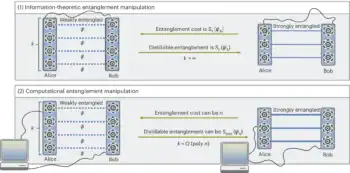
Quantum sensors based on microscopic flaws in the crystalline structure of diamond can work at pressures as high as 140 gigapascals, according to research by physicists at the Chinese Academy of Sciences in Beijing. The finding sets a record for the operating pressure of quantum sensors based on so-called nitrogen vacancy (NV) centres, and their newfound durability could benefit studies in condensed-matter physics and geophysics.
NV centres occur when two neighbouring carbon atoms in diamond are replaced by a nitrogen atom and an empty lattice site. They act like tiny quantum magnets with different spins, and when excited with laser pulses, the fluorescent signal they emit can be used to monitor slight changes in the magnetic properties of a nearby sample of material. This is because the intensity of the emitted NV centre signal changes with the local magnetic field.
The problem is that such sensors are fragile and tend not to work in harsh conditions. This makes it difficult to use them for studying the Earth’s interior, where gigapascal (GPa) pressures prevail, or investigating materials like hydride superconductors, which are fabricated at very high pressures.
Optically detected magnetic resonance
In the new work, a team led by Gang-Qin Liu of the Beijing National Laboratory for Condensed Matter Physics and Institute of Physics, Chinese Academy of Sciences, began by creating a microscopic high-pressure chamber known as a diamond anvil cell in which to place their sensors, which consisted of microdiamonds that contain an ensemble of NV centres. Sensors of this type work thanks to a technique called optically detected magnetic resonance (ODMR) in which the sample is first excited using a laser (in this case with a wavelength of 532 nm) and then manipulated via microwave pulses. The researchers applied the microwave pulses using a thin platinum wire, which is robust to high pressures. The final step is to measure the emitted fluorescence.
“In our experiment, we first measured the photoluminescence of the NV centres under different pressures,” explains Liu. “We observed fluorescence at nearly 100 GPa, an unexpected result that led us to perform subsequent ODMR measurements.”
A large ensemble of NV centres in one spot
While the result was something of a surprise, Liu notes that the diamond lattice is very stable and undergoes no phase transition, even at pressures of 100 GPa (1Mbar, or nearly 1 million times Earth’s atmospheric pressure at sea level). And while such high pressures do modify the energy levels and optical properties of NV centres, the modification rate slows down at higher pressures, allowing the fluorescence to persist. Even so, he tells Physics World it was “no easy task” to obtain ODMR spectra at Mbar pressures.
“There are many technical challenges we have to overcome,” he says. “One in particular is that high pressures decrease the NV fluorescence signal and bring extra background fluorescence.”
The researchers overcame these problems by using a large ensemble of NV centres (~5 × 105 in one single microdiamond) and optimizing the light-collection efficiency of their experimental system. But their worries did not end there. They also needed to avoid a large pressure gradient over the sensor, as any inhomogeneity in the pressure distribution would have broadened the OMDR spectra and degraded the signal contrast.
“To meet this challenge, we chose potassium bromide (KBr) as the pressure medium and confined the detection volume to about 1 um3,” says Liu. “We were able to obtain ODMR of NV centres at nearly 140 GPa using this approach.”
The maximum pressure may be even higher, he adds, since the pressure-induced modifications of the energy levels in NV centres turned out to be smaller than expected. “The key challenge to achieve this goal is to produce high pressures with small or no pressure gradient,” Liu says. “This might be possible using noble gas as the pressure-transmitting medium.”

Quantum gravity gradient sensor used outdoors to find tunnel
According to Liu and colleagues, these experiments show that NV centres could be used as in situ quantum sensors for studying the magnetic properties of materials at Mbar pressures. One example might be to probe the Meissner effect (magnetic field exclusion) in LaH10 , a high-temperature superconductor that can only be synthesized at pressures above 160 GPa.
The researchers now plan to optimize their sensors and determine their high-pressure limit. They also hope to improve their magnetic sensitivity (by optimizing the fluorescence collection efficiency) and develop multi-modal sensing schemes – for example, measuring temperature and magnetic field simultaneously.
They detail their present study in Chinese Physics Letters.



